1920's French Legras Cameo Art Glass Vase

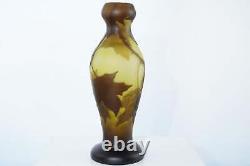
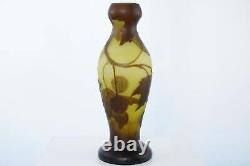
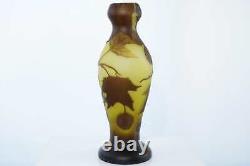
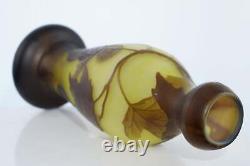
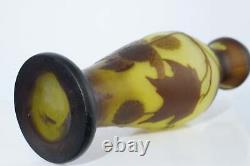

1920's French Legras Cameo Art Glass Vase. 9 tall with no cracks, chips, or restoraitons. The Legras glassworks - ultimately a multi-centred concern employing hundreds of people across several manufacturing centres - produced enough highly-distinctive pieces to be considered an art-glass movement in its own right.
It's more accurate, of course, to consider the name one of the foremost in the panoply of innovative, experimental and overtly artistic producers who revolutionised decorative glassware from the mid 1860's, throughout the fin de siècle, across the duration of the Great War and beyond The founding father of the company, François-Théodore Legras, came from humble stock, having be life as a woodsman in the Vosges department south of Strasbourg. In 1859, Legras determined that there was potentially more to life than trees and leaves, and secured himself a clerical apprenticeship at the glassworks in Clairey, a long-established manufactory producing drinking glasses and tableware which - crucially for Legras - included the manufacture of crudely-frosted pieces.
After learning his trade for five years, Legras moved to Paris and took a job at the Plaine St Denis factory, securing a senior managerial role by the age of 27. He was director of the works when, underwritten by expat-philanthropist Sir Richard Wallace, it was significantly extended and modernised; the duo also took over another factory at Pantin, on the northern fringes of the city.
Unrestrained by the financial strictures of facilities lacking patrons such as Wallace, Legras was able to encourage an experimental approach to glass production, harking back to his childhood in the Darney Forests and using opaque glass - based on Clairey's frosted material - as a canvas on which designs could be created. The businesses were also underwritten by the production of utilitarian glassware for industry - distilleries and pharmacies - and this security gave François-Théodore the freedom to develop his art-glass production techniques. Intricately cut cameo glass pieces, acid-etched and enamelled imagery - requiring up to five separate firing processes to achieve the desired effect - became the Legras hallmark, with many pieces featuring forested landscapes and the favoured themes of the artistic director - irises, orchids and chrysanthemums.Additional members of the Legras family were apprenticed in to the company, notably a nephew - Charles - whose expertise in the chemical treatment of glass to produce marbled, opaline surfaces on which designs could be overlayed, was to prove a valuable commodity. Charles was ultimately to take over the running of the businesses in 1909, seven years before the death of his uncle. He was able to maintain a level of innovation which sustained the company for another decade - achieving notable successes in developing synthesised "gemstones" which could be ground up and incorporated in to the glass melt to give an extraordinary depth of colouration which provided the base for the production of striking cameo vessels.

